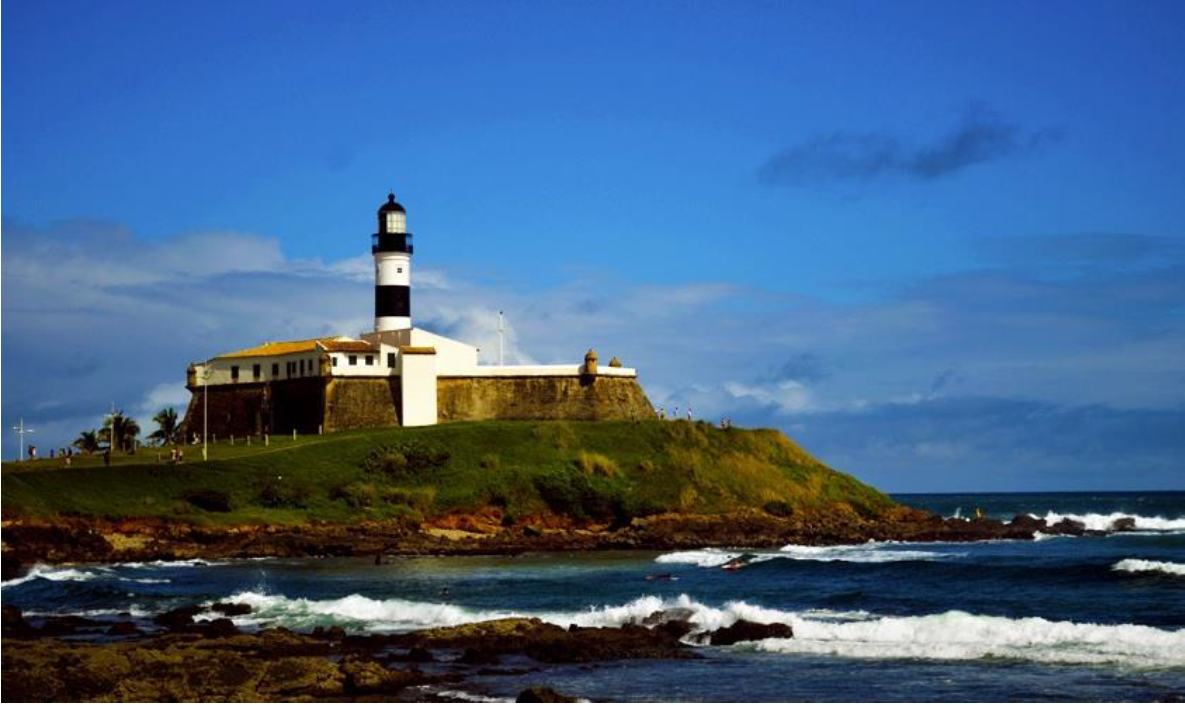Santo Antônio da Barra
IALA Heritage Lighthouse of the Year 2020
Location: BRAZIL - Bahia. Salvador.
Lighthouse Operator: Brazilian Navy

Source: (photos as submitted to accompany nomination form by Brazilian Navy - Directorate of Hydrography and Navigation Center of Aids to Navigation “ALMIRANTE MORAES REGO” in 2020)
Lighthouse Description and History
| (Text extracted from nomination form submitted by Brazilian Navy – Directorate of Hydrography and Navigation Center of Aids to Navigation “ALMIRANTE MORAES REGO” in 2020) |
| The Santo Antônio da Barra Lighthouse is one of the icons of the city of Salvador, Bahia, Brazil.
Salvador was founded in 1549, from the place where the Portuguese Tomé de Souza (1503-1579) landed, less than one kilometer from where today the Santo Antônio da Barra Fortress is located, within which the Lighthouse is situated. Salvador was the first capital of Brazil as a Colony of Portugal, from 1549 to 1763, when the city of Rio de Janeiro became the capital of the Colony. In order to further protect the city, from 1583 to 1587, the first military fortress was erected at Point of Santo Antônio da Barra. In the 17th century, the port of Salvador was one of the busiest and most important on the continent, frequented by many ships sailing from Africa and Europe. After many accidents in the region, there was the tragic shipwreck of the Galleon Santíssimo Sacramento, which hit the Santo Antônio shallow in 1668, victimizing more than 400 people. In 1697, the quadrangular tower of the first lighthouse started to be constructed , taking advantage of the rebuilding of the Fortaleza that began a year earlier, 1696. In March 1699, explorer and privateer Willian Dampier records that he saw the signal lights of the lighthouse of the Santo Antônio da Barra Fortress and drew a sketch of the entrance to “Baía de Todos os Santos” (“All Saints” Bay), within which the city Salvador is located. A new tower, in a conical shape, was built between 1836 and 1839, painted white. The new Lantern housed a rotating white and red catoptric device with a range of 15 Nautical Miles. In 1890, a new lenticular device, 1st order dioptric BBT, was installed, which is still in operation today. In 1936, the lighthouse was electrified. In 1955, its rotation system was replaced, and the lenticular assembly started to rotate supported on an SKF ball collar with 380 mm outside diameter, 280 mm inside diameter and 80 mm high, which works perfectly even today. In 1969, its tower, until then white, changed to white and black bands, improving its daytime identification, committed to the vertical growth of the city of Salvador. |
Reason For Nomination
| (Text extracted from nomination form submitted by Brazilian Navy – Directorate of Hydrography and Navigation Center of Aids to Navigation “ALMIRANTE MORAES REGO” in 2020) |
| Intrinsic Heritage Interest of the Lighthouse
Santo Antônio da Barra Lighthouse is the oldest lighthouse in operation on the coast of Brazil and the Americas, having been proven through historical documents from a primary source that the construction of its first tower began in 1697. That same year, Portugal sent the glasses and the lead to caulk for the assembly of the light source protection pane. The Santo Antônio da Barra Lighthouse also is, to the best of our knowledge, the oldest lighthouse in the southern hemisphere. It is located at the entrance of the wide Bay of “Todos os Santos” (All Saints), known by the Indians who inhabited the region, the Tupinanbás, as “Kirimurê”, or “Great Inland Sea”. The name “Baia de Todos os Santos” was attributed to this bay by Gaspar Lemos, who, along with Américo Vespúcio, entered the bay with his ships on November 1st, 1501, “All Saints Day”. For the protection of foreign invasions, in 1534, the Portuguese began to build the first and rudimentary military fortification for the defense of “Baía de Todos os Santos” then called “Ponta do Padrão” (Landmark point), very close to the place where Gaspar Lemos landed in 1501. Today the name of this geographical point is “Ponta de Santo Antônio”. The first tower, described as “a quadrangular turret topped by a glazed bronze lantern” had its construction started on 1697, when glass and lead for caulking were also sent from Portugal, intended for the assembly the protection structure of the lighthouse’s light apparatus, consisting of lamps powered by whale oil. On 1698, the lighthouse was ready, on a precise date unknown. There are few historical records about this tower; ironically, on November 1st, 1755, again on All Saints Day, Lisbon was swept away by an earthquake, followed by a tsunami and many fires, when several documents have been lost. Salvador was founded on March 28, 1549, when the construction and development of the city began, behind the already existing Fort and, later, also in the shadow of the Lighthouse built inside the fortress. Currently, Salvador is a city with almost three million inhabitants. Considering the speed of development of the cities of the then colony of Portugal, it can be said that Salvador grew and developed from and under the light of the Santo Antônio da Barra Lighthouse, which can be considered as its main point of reference, symbolically its “Ground Zero”. It is remarkable the identity of the Lighthouse with the City, what makes it present in many activities with different characteristics related to Salvador, or that are carried out in it. The Lighthouse has literally been a postcard of Salvador for a long time. |
| Conservation
Tower Optical Equipment Light Source Rotation System Visibility Sector |
| Public Access and Education
Public Access Educational and Cultural Projects
|
